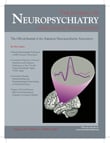Use of Clozapine in Oneroid State
SIR: Oneroid state is an uncommon psychiatric disorder, which has been given little attention in recent classificatory systems. Older textbooks of psychiatry have described it as schizophrenia with a clouding of consciousness and as occurring mostly in the acute stage of schizophrenia. 1 It is characterized by a kaleidoscopic quality of psychopathological experiences wherein reality, illusions, and hallucinations are merged into one. 2 In such a state, a patient may be deeply perplexed and not fully oriented to time and place. I wish to report an adolescent girl who exhibited oneroid state with no basis for organicity, and who responded well to clozapine after failure of trials with haloperidol and risperidone.
Case Report
“Ms. A” is a 19-year-old unmarried woman from a socioeconomically lower class urban family. In the past, she developed an illness suggestive of paranoid schizophrenia (ICD 10 Criteria), characterized by withdrawn, abusive and violent behavior, delusions of persecution, and inappropriate affect of 5-month duration. She recovered spontaneously and was symptom-free for the next 2 months. Subsequently, she presented to us with confusional behavior without any apparent psychological or physical precipitating factor. Her confusional behavior lasted for 15 days and was almost continuous. During this time, she misidentified her family members and had urinary incontinence. She muttered and talked incoherently. Mental status examination revealed increased psychomotor activity, verbal stereotypy, and perseveration with loosening of association and perplexed mood. She exhibited double orientation and double book-keeping phenomena. 3 , 4 At times, she would misidentify the doctor as her brother, but on other occasions, she behaved like a patient with the same doctor. She would misidentify the hospital as her home and name a few patients as her relatives. She labeled half of the hospital as her house and half as the hospital. While in the hospital, she would follow regular hospital routine. Her look was perplexed. She had fleeting delusions of persecution, rapidly shifting visual hallucinations, and illusionary distortion of perceptual processes on several occasions.
A detailed, meaningful cognitive assessment was not possible in view of her persistent perplexity. Medical and neurological referrals were taken and no deficit was detected upon a detailed physical examination. Her computed tomography (CT) head scan and electroencephalogram (EEG) were normal. A routine hematological and biochemical investigation did not reveal any abnormal findings. She was put on a regimen of haloperidol, 20mg/day for 3 weeks, and, subsequently, risperidone, 6mg/day, with no improvement. Ultimately, I started her on a regimen of clozapine, and gradually increased the dosage to 200mg over a period of 3 weeks, with proper monitoring of leukocyte count. Ms. A showed marked improvement with clozapine not only in thinking but in her confusional behavior. Hence, she was stabilized on the same dose for 3 months without any relapse.
Comment
Oneroid state is a neglected condition probably because it deals more with clinical descriptions than with a phenomenological approach. This case did not fit into any category of the current psychiatric classificatory system. In contrast to our report where clozapine has been used successfully, there have been few reports of clozapine-related delirium or confusion. 3 In such cases, clozapine’s anticholinergic properties or concomitant anticholinergic or CNS depressant medications may have been responsible for the delirium.
In conclusion, clozapine can be used safely in patients with functional confusional psychoses, such as oneroid state; hence, it may be considered as the first line of treatment. Further systematic collection of data in this regard may add to the confidence in prescribing clozapine in this state.
1. Mayer-Gross: Schizophrenia, in Clinical Psychiatry, 3rd ed. Edited by Slater E, Roth M. London, Bailliere Tindall, 1965, pp 237–341Google Scholar
2. Kaptsan A, Miodownick C, Lerner V: Oneroid syndrome: a concept of use of for Western psychiatry. Isr J Psychiatry Relat Sci 2000; 37:278–265Google Scholar
3. Sims A: The disordered self, in Symptoms in the Mind, 3rd ed. Edited by Sims A. London, Saunders, 2003, pp 209–229Google Scholar
4. Gancro R, Lehmann H: Schizophrenia: clinical features, in Comprehensive Textbook of Psychiatry, 7th ed. Edited by Sadock BJ, Sadock VA. New York, Lippincott Williams & Wilkins, pp 1169–1199Google Scholar
5. Iqbal MM, Rahman A, Husain Z, et al: A clinical review of adverse effects and management. Ann Clin Psychiatry 2003; 15:33–48Google Scholar



